|
|
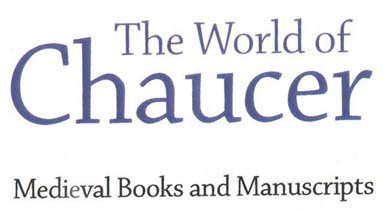
 |
Medicine, Magic and Monks
Introduction to Medicine, Magic and Monks
| Descriptions of books with images
With us ther was a DOCTOUR OF PHISIK;
In al this world ne was ther noon hym lik,
To speke of phisik and of surgerye,
For he was grounded in astronomye.
He kepte his pacient a ful greet deel
In houres by his magyk natureel. |
General Prologue to The Canterbury Tales (l. 411-416).
Disease and death were never far away in the late medieval world. Fourteenth
century society was especially ravaged by successive outbreaks of the plague
that came later to be known as the ‘Black Death’. The pestilence was carried to
Italy in 1347 from the Middle East by sailors and reached England by 1348. It is
estimated that at least a third and up to half of the population had died of
this horrific disease by the end of the century. The far reaching consequences
of this catastrophic loss of life included an immediate shortage of goods and
labour, leading to wage increases, and increasing social mobility and
dissatisfaction amongst the labouring classes. Despite this burgeoning social
unrest, day to day life was incredibly never seriously interrupted: if anything,
the ever present threat of death and disease gave medieval people a greater lust
for life. Chaucer’s works are certainly not pervaded by any great sense of
morbidity, although he was undoubtedly affected by the disease. Indeed, many members of
his father’s family were wiped out in the worst outbreak of 1348-49. Ironically, this resulted in John Chaucer receiving an
unexpected inheritance, leading to the social elevation of the family.
Religion was an overwhelming force in medieval society. Immersion in a
Christian mentality was so profound that for most people it would have been
impossible to conceive of a meaningful existence without God and the tenets of
faith. Yet there was also a growing dislike of the organised Church because of
its ostentatious richness. As the Bible became more accessible to laymen through
its translation into English, its teachings in praise of poverty were taken to
heart, giving rise to anti-clericalism and movements such as Lollardy.
The relationship between belief in God and an understanding of science was
also fraught with tension. Astrology, for example, was generally accepted by the
Church as a valid science, as long as it did not overstep prescribed bounds in
encouraging a belief in predestination at variance with the doctrines of Divine
Providence and free will. In reality, belief in astrology and the influence of
the stars and planets was endemic, and many professionals relied upon it in
making decisions. Since it depended upon a knowledge of cosmological theory,
astrological works were often found in conjunction with works on astronomy, and
the two were regarded as more or less interchangeable. Chaucer himself was
knowledgeable about cosmology, and he wrote at least one technical work on the
subject, A Treatise on the Astrolabe. From references throughout his works, it
is obvious that he was similarly interested in many other branches of science,
including medicine, physics, and alchemy, that esoteric art known best for its
quest for the philosopher’s stone and attempts to turn base metal into gold.
|
|
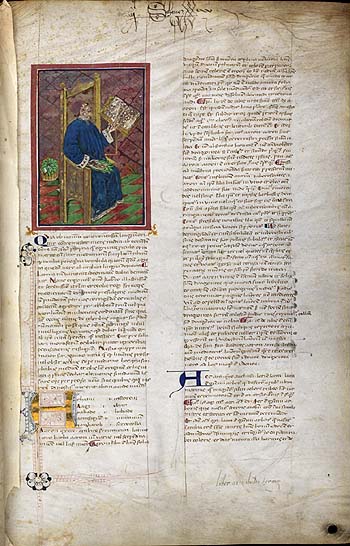
Miniature of physician at head of dictionary of medicine (folio 18r) |
Raymond Chalin De Vinario De Epidemia
Italy: late Fourteenth Century
MS Hunter 35 (T.1.3)The first text in this volume is a copy of Raymond Chalin de Vinario’s
treatise on epidemic disease, De Epidemia. Chalin De Vinario studied medicine at
Montpellier and practised as a physician in Avignon, where he observed and
treated the plague which raged throughout the Fourteenth Century. His detailed
accounts of the symptoms of the victims of pestilence include descriptions of
the characteristic black blotches that broke out on the body, as well as the
coughing of blood. Although he pronounced the plague to be incurable, in his
efforts to treat his patients he tried blood-letting, cupping and lancing the
boils with red-hot irons.
| The miniature at the head of the second text in the volume depicts a
crimson-capped figure reading a book and holding some herbs. There is a basket
full of the same herbs behind him. This is a dictionary of medicine by an
unknown author. At the top of the page is the name ‘Scheuez’. William Schevez
was Archbishop of St. Andrews (1478-97); his name occurs in several other places
in the manuscript, along with other early autographs and ownership inscriptions,
including that of John Hake, ‘of ye brugh of perth.’ |
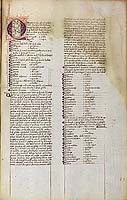
Entry for 'Q' from dictionary of medicine (folio 177r) |
|
|
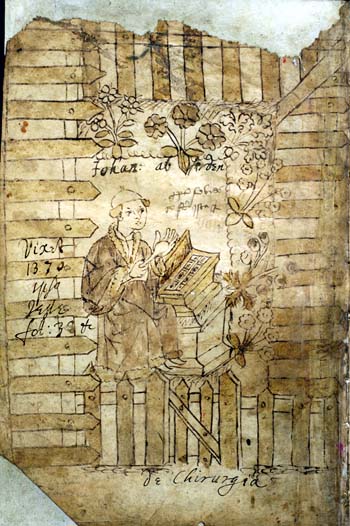
Frontispiece depicting John of Arderne (folio 1v) |
John of Arderne Mirror of Phlebotomy & Practice of Surgery
England: late Fourteenth/early Fifteenth Century
MS Hunter 112 (T.5.14)John of Arderne was the most famous doctor of Chaucer’s day. As well as
practising his craft in Nottinghamshire and London, he may well have developed
his skills on active service during the Hundred Years' War. He wrote a number of
treatises on general medicine and surgery, including these works on phlebotomy
and on the cure of anal fistula, one of the deadliest operations in medieval
surgery. Only the rich could afford doctors: Chaucer’s description in the
General Prologue of his silken-clad Doctor of Physic who ‘lovede gold’ hints at
how expensive they were. In fact, the Practica of Fistula in Ano not only
discusses surgical matters, but also advises on how doctors should behave and
what fees they should charge. Arderne recommends that a doctor should never take
less than five pounds - more than most people earned in year.
The unusual frontispiece with which this copy begins shows a physician with a
medicine box and ladle sitting within a herb garden. The rather rudimentary
drawing of this picture and of the illustrations throughout the volume suggests
a provincial origin. This manuscript has obviously been well used, and there are
extensive annotations by early readers, including additions of medical recipes.
|
|
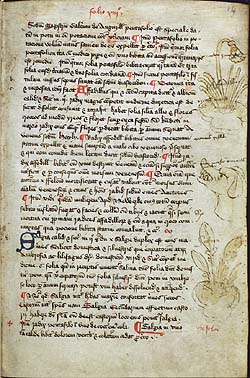
Page with marginal illustrations (folio 14r) |
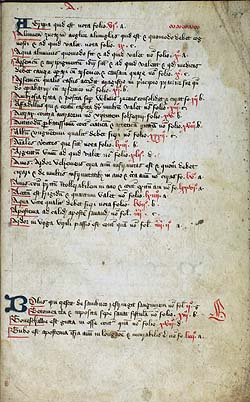
Index (folio 97r) |
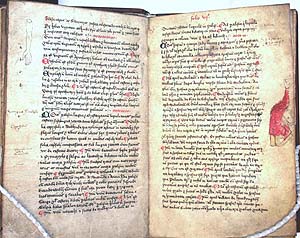
Opening with marginal illustrations (folios 6v - 7r) |
|
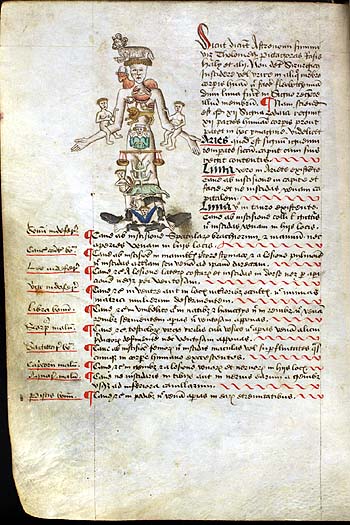
Illustration of a ‘zodiac man’ (folio 47v) |
John of Arderne Mirror of Phlebotomy & Practice of Surgery
England: c.1425-1450
MS Hunter 251 (U.4.9)Thought to have lost only half of his fistula patients, Arderne was
considered a remarkably successful surgeon. His great advance at the time was to
avoid the corrosive after-care treatment used by other practitioners. In other
respects, he was more traditional, practising astrology in the diagnosis,
treatment and prognostication of ailments, as was the norm. The link between
astrology and medicine is typified in the ‘zodiac man’, a representation of
celestial influence on the human body found in hundreds of medieval medical
manuscripts. Here, the zodiacal symbols are painted on the body in the
appropriate places, from Aries for the head and face to Pisces for the feet. The
signs demonstrate which parts of the body are influenced by which astrological
sign, thus indicating the most auspicious times for performing operations.
This is a later and more elaborately decorated copy of Arderne’s works. In
common with other Arderne manuscripts, it contains interesting diagrams of
instruments and of treatments to be effected, closely co-ordinated with the
text. The illustrations perform a practical function in demonstrating visually
examples of plants and herbs to be used in making up curative recipes as well as
surgical techniques. They were vital in the transmission of the text, and were
faithfully copied from manuscript to manuscript.
|
|
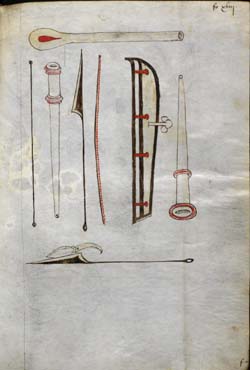
Surgical instruments (folio 43r) |
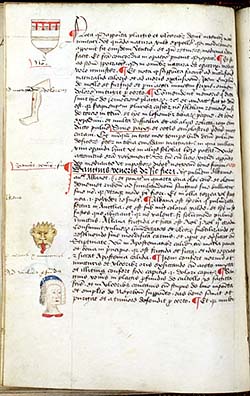
Page with marginal illustration (folio 60v) |
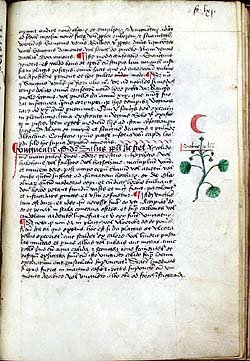
Page with marginal illustrations (folio 61r) |
|
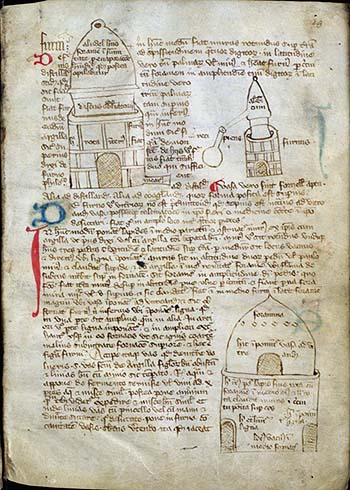
Page with illustrations of alembics and furnaces
(folio 28r) |
Alchemical treatises
England: late Fourteenth Century
MS Hunter 110 (T.5.12)The craft of alchemy developed significantly in the Thirteenth Century and it
is consequently the subject matter of a large number of surviving late medieval
manuscripts. This literature incorporates a spectrum of works, ranging from
those dealing with technical metallurgical matters to those couched in mystical
language concerning the transmutation of base metals into gold. This manuscript
is a compendium of texts. Included are works by the thirteenth century Dominican
scholar Albertus Magnus, William de Furnivall’s On the Sublimation of Arsenic, a
copy of the Mappae Clavicula, a dictionary of alchemical terms, and anonymous
treatises on salt and divination. The opening displayed to the left is from Albertus
Magnus’s Straight Path in the Art of Alchemy. It is illustrated with simple
diagrams of furnaces, used to ‘sublime’ or distil various substances. The
illustrations in alchemical works are often unsophisticated, but nonetheless
essential in books that were intended to be used in intensely practical ways.
The first part of Chaucer’s Canon’s Yeoman’s Tale provides a fascinating
account of the workings of an alchemist’s laboratory with its unending and
elusive experimentation. Although Chaucer refers to the craft as a ‘slidynge
science’, he takes great delight in listing the strange names of the chemicals
and processes, and obviously had some practical knowledge of chemistry.
|
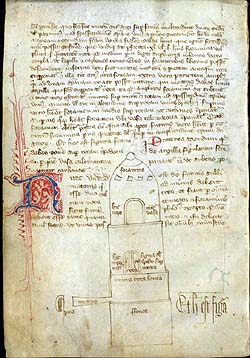
Page with illustration of furnace (folio 27v) |
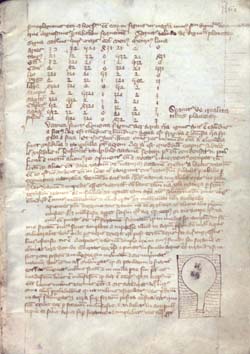
Illustrated page from Albertus Magnus' The Secret
of Philosophers (folio 62r) |
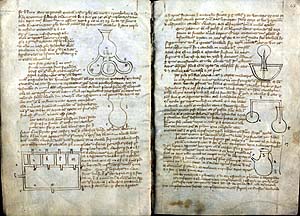
Illustrated opening from
Albertus Magnus' The Secret of Philosophers (folios 67v - 68r) |
|
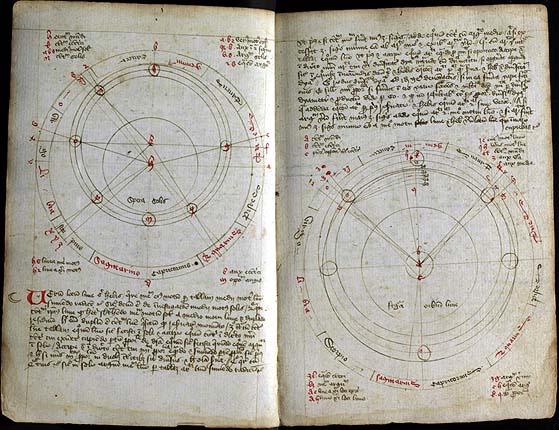
Opening with illustrations of planetary orbits (folios 17v-18r) |
Astrological treatises
France?: Fourteenth/Fifteenth Century
MS Hunter 461 (V.6.11)Over twenty treatises written in a variety of hands have been brought
together in this compilation. Included are works that cover varied aspects of
medieval science: medicine, computation, arithmetic, music, astronomy and
astrology. The first part of the volume contains several astrological texts. As
well as an introduction to the subject, there are treatises on the virtues of
the moon, the conception of the sphere and its diverse circles, the quantities
of the stars and planets, the motion of the eighth sphere, the motion of Aries
and Libra, and the theory of the planets.
The opening displayed to the left is from an illustrated treatise on the motions of the
planets by an unknown author. The diagrams show planetary orbits in connection
with the workings of the sun and the moon; both are seen in relation to zodiacal
positions (marked on the outermost perimeter of the spheres), underlining the
inseparability of medieval astronomy and astrology. It was believed that the
earth was at the centre of a concentric planetary system and that each planet
could affect human life in particular and different ways. Thus, in The Knight’s
Tale, Arcite registers his sense of being under planetary control by blaming
Saturn for his misfortune.
|
|
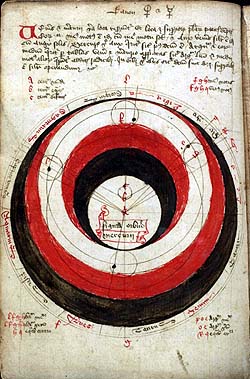
Orbit of Mercury (folio 19v) |
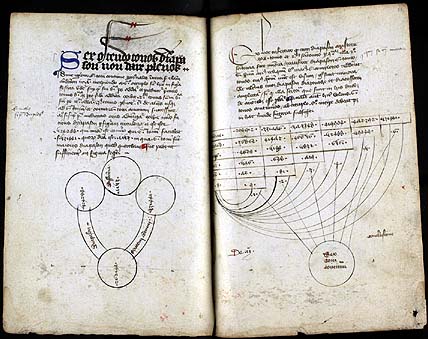
Opening from Johannes de Muris' Treatise on Musical
Intervals (folios 52v - 53r) |
|
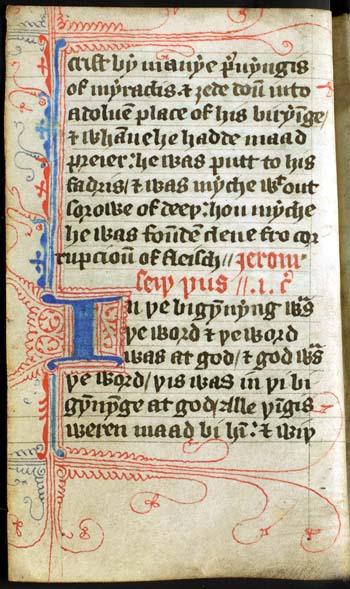
Opening of beginning of St. John’s Gospel (folio 2v) |
John Wycliffe New Testament
England: late Fourteenth Century
MS Hunter 191 (T.8.21)John Wycliffe’s fourteenth-century translation of the Bible into English was
a groundbreaking publication. A notorious theologian whose teachings were
condemned by the Pope, he systematically attacked the abuses and practices of
the medieval church, insisting that it should give up its worldly wealth. His
controversial views were propagated by the Lollards, a heretical group with whom
Chaucer’s Parson seems to share some sympathies. The movement was remarkable for
its demand to read the Bible in English. Although attacked and forced
underground in the Fifteenth Century, the numerous examples of vernacular Bibles
surviving from this period are some indication of the popular influence of the
Lollards.
The famous beginning of St. John’s Gospel is shown here: ‘In þe bigynnyng was
| þe word & þe word | was at god, & god was | þe word.’ It is preceded by a
prologue to the Gospel. This plain, pocket sized volume contains only an
incomplete copy of the New Testament. Many Wycliffite Bibles were made
deliberately small like this one to enhance their portability for use by
itinerant preachers. Although we do not know who originally owned this copy,
there are numerous sixteenth and seventeenth-century ownership inscriptions on
the flyleaves, including a note that it belonged to John Lewis (1675-1747), an
early biographer of Wycliffe.
|
|
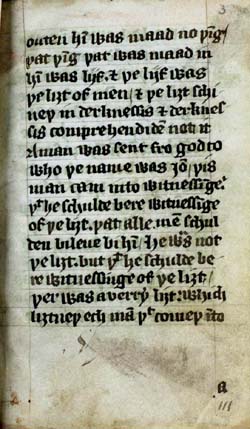
Continuation of St. John's Gospel (folio 3r) |
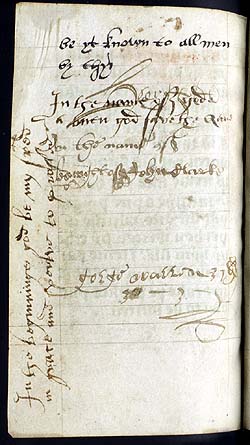
Blank leaf with annotations (folio 104v) |

Beginning of the Epistle of James (folio 105r) |
|
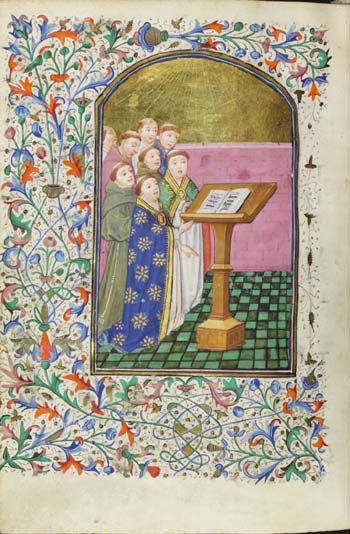
Miniature of monks in choir opposite text of Psalm 96
(folios 197v-198r) |
Book of Hours
Bruges: c.1450-1460
MS Gen 288Books of Hours are compendiums of devotional texts designed for the laity to
use in private prayer. At their centre is a series of prayers and psalms known
as 'The Hours of the Virgin', to be recited daily at set 'hours' to aid
salvation. Books of Hours were extremely popular throughout the Middle Ages and
more were produced than any other type of book. Many were personalised and
lavishly illuminated to the further glory of God. This combined Book of Hours
and Psalter boasts eighteen full page pictures on single leaves, painted
separately and inserted into the completed volume at the beginnings of major
sections of text. The border decoration of the pictures is matched on the facing
page in a single unified design; the unstinting use of incised gold leaf truly
illuminates the text.
The miniature to the left depicts monks singing in choir. The text
opposite is appropriately that of Psalm 96, ‘Sing to the Lord a new song: sing
to the Lord, all the earth’. By the Fourteenth Century, complex polyphonic
settings had extended to all sung parts of the Mass resulting in the music
usually being left to the choir, who sang on behalf of those present. The
difficulties of this outstanding music required an ability to read musical
notation, as intimated by this illustration.
The other illustrations are also from the psalter section of the volume. That
on folio 156v is set before Psalm 52 ('The fool said in his heart: There is no
God') and that on folio 168v refers to Psalm 68 ('I am come into the depth of
the sea: and a tempest hath overwhelmed me').
|
|
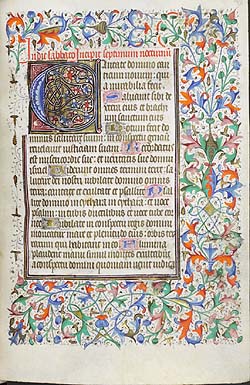
Psalm 96 (folio 198r) |
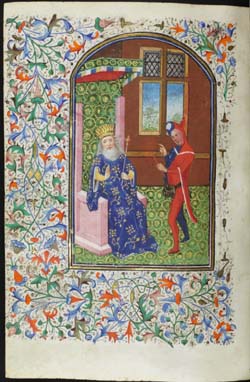
(folio 156v) |
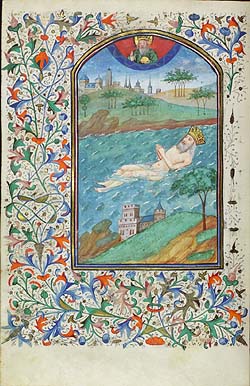
(folio 168v) |
|
|